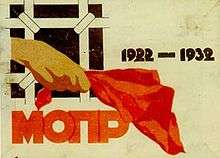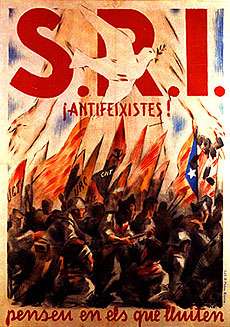International Red Aid
International Red Aid (also commonly known by its Russian acronym MOPR, for Междунаро́дная организа́ция по́мощи борца́м револю́ции) was an international social service organization established by the Communist International. The organization was founded in 1922 to function as an "international political Red Cross", providing material and moral aid to radical "class war" political prisoners around the world.
- Not to be confused with Workers International Relief (aka Mezhrabpom), established by the Comintern in 1921 to channel international aid to Soviet Russia during the famine.
 MOPR label (1932) | |
| Founded | 1922 |
|---|---|
| Founder | Comintern |
| Dissolved | 1941 (Soviet affiliate - 1947) |
| Focus | "assistance in the creation of organizations to render material and moral aid to all captives of capitalism in prison." |
Area served | worldwide |
Key people | Julian Marchlewski Clara Zetkin Elena Stasova |
Organizational history
Formation
The International Workers Aid society, known colloquially by its Russian-language acronym, MOPR,[1] was established in 1922 in response to the directive of the 4th World Congress of the Comintern to appeal to all communist parties "to assist in the creation of organizations to render material and moral aid to all captives of capitalism in prison."[2]
Julian Marchlewski-Karski was named chairman of the Central Committee of MOPR, the governing body of the new organization. After 1924, the name of this directing body was changed to the Executive Committee.[3]
The first plenary session of the Central Committee of MOPR was held in June 1923 in Moscow. At this gathering it was determined that MOPR should establish sections in all countries, particularly those suffering from so-called "White terror" against the revolutionary movement.
Development
The first international conference of MOPR took place in July 1924, simultaneously with the 5th World Congress of the Comintern.
According to Elena Stasova, the head of the Russian section of MOPR and deputy head of the Central Committee of the International organization, as of January 1, 1928, MOPR had a total membership of 8,900,000 people in 44 national sections. By January 1, 1931, MOPR's scope had grown to 58 national organizations, with a total membership of 8,305,454, according to Stasova.[4] At the latter date the international organization maintained a total of 56 periodicals in 19 languages, Stasova stated.[5]
Stasova noted that two forms of the organization existed, "mass organizations" — such as those of the USSR, Germany, France, the United States — and "organizations of a committee type", which limited themselves to legal and material aid to political prisoners and their families without attempting to establish large-scale membership organizations.[6]
Stasova emphasized the ongoing difference between MOPR and Workers International Relief, another branch of the Comintern's international apparatus. "The difference is this", she noted in 1931, "we are assisting the political prisoners and the Workers International Relief assists at the time of economic strikes, at the time of the economic struggle."[7]
The 1st World Congress of MOPR was held in November 1932. At that gathering it was announced that as of January 1 of that year, MOPR had established 67 national sections outside of the USSR, with 1,278,274 members.[8]
Termination
MOPR was headed by Elena Stasova until 1938, after which time its international character was deemphasized.
National histories
As of 1924 the organization had national affiliates in nineteen countries. By 1932 it claimed sixty-two affiliates (excluding the Soviet Union) with a total of 1,278,274 individual members.[9]
Spain
The International Red Aid made its first appearance in Spain as a charity organization during the workers’ revolt of October 1934 in Asturias. It provided aid to those imprisoned for their role in the rebellion, and organize amnesty campaigns for prisoners that were to be executed.
The organization, which included many artists and writers, was later re-formed and expanded in Barcelona in January 1936, with the aim of opposing fascism on multiple fronts.
Activities during the Spanish Civil War

During the Spanish Civil War, the writer Joaquín Arderíus served as the organization's president before exiling himself to France and then Mexico. The SRI created soup kitchens and refugee camps throughout the territory controlled by the Republicans, and also provided libraries for Republican soldiers, but many of their programs –as well as the food and aid that it collected- were focused on providing aid for children. For example, the SRI founded the Escuela Nacional para Niños Anormales (National School for Mentally Disabled Children) in Madrid, with 150 students. It also founded a Children's Park on the outskirts of Madrid, providing shelter to an additional 150 children.
Other activities included:
- The building of transportation networks between hospitals and the front.
- The transformation of various buildings (convents, churches, palaces) into makeshift hospitals, clinics, blood banks, orphanages, and schools.
Medical contributions included the establishment of 275 hospitals, ambulance services, the establishment of the Orthodontics Clinic and College, dental hygiene campaigns, and the mobilization of dentists to the front. The Workers' Party of Marxist Unification (POUM), a minor Marxist party in Spain at the time, organized a parallel Socorro Rojo del P.O.U.M. in opposition to the International Red Aid.[10]
Military activities
The ranks of the Fifth Regiment (dissolved January 21, 1937), established by the Communist Party of Spain at the outbreak of the Civil War, were also swelled by members of the SRI. The Fifth Regiment, based on the Soviet Red Army, included Juan Modesto and Enrique Líster amongst its leaders, and fought primarily in the battles in and around Madrid throughout 1936. The SRI also helped Communist sympathizers in Nationalist Spain make their way to friendly territory.
The insignia of the SRI consisted of an "S" (for Socorro) behind the bars of a prison.
Netherlands
The Dutch section of International Red Aid held its first congress in 1926.[11] The same year it began publishing Rode Hulp.[12]
Finland
The Red Aid of Finland was active during the 1930s, led by the Communist Party of Finland. It gave assistance to revolutionary prisoners in Finnish jails. Women connected to Red Aid would make handicraft works and organized bazaars, in order to finance the activities of the organization. The organization also tried to mobilize public opinion against ill-treatment of the prisoners. The Red Aid of Finland published Vankien Toveri.[13]
Latin America
Towards the ends of the 1920s, Farabundo Martí became the leader of the International Red Aid in Latin America.[14] Julio Antonio Mella, the Cuban communist leader exiled in Mexico since 1926, was a leading figure in the Mexican section of the organization.[15]
Soviet Union
The largest section of MOPR was its Soviet branch, which accounted for the majority of the organization's international membership. MOPR organized numerous lotteries and fundraising drives.
Korea
Yi Donghwi was a prominent MOPR organizer.[16]
In Madagascar
A MOPR branch was formed in Madagascar in 1933.[17]
See also
| Wikimedia Commons has media related to International Red Aid. |
Footnotes
- The full Russian name of the organization was Международная организация помощи революциoнepaм ("International Organization for Aid to Revolutionaries"). This can be transliterated Mezhdunarodnaia Organizatsiia Pomoshchi Revoliutsioneram — MOPR.
- Cited in Branko Lazitch and Milorad M. Drachkovitch, Biographical Dictionary of the Comintern: New, Revised, and Expanded Edition. Stanford, California: Hoover Institution Press, 1986; pg. xxviii.
- Lazitch and Drachkovitch, Biographical Dictionary of the Comintern, pg. xxviii.
- H. Stassova [E. Stasova], MOPR's Banners Abroad: Report to the Third MOPR Congress of the Soviet Union. Moscow: Executive Committee of IRA, 1931; pp. 12-13.
- Stassova, MOPR's Banners Abroad, pg. 30.
- Stassova, MOPR's Banners Abroad, pp. 15-16.
- Stassova, MOPR's Banners Abroad, pg. 19.
- Lazitch and Drachkovitch, Biographical Dictionary of the Comintern, pg. xxix
- Lazitch 1986, p. xxix.
- ALBA - Articles - "Shouts from the wall." USF Magazine. 4 (Fall) 1997. pp. 24-27 Archived 2008-09-07 at the Wayback Machine
- Lijst Van Geraadpleegde Literatuur Archived February 5, 2012, at the Wayback Machine
- Universiteit Maastricht (bibliotheek) - results/illegal
- Suomen Punainen Apu (Kansan Arkisto)
- "ALBA .:Alternativa Bolivariana para los Pueblos de Nuestra América - Content - BIOGRAFÍA". Archived from the original on 2011-07-25. Retrieved 2006-09-06.
- "Fuentes," www.difusioncultural.uam.mx/
- 이동휘 (李東輝 ; 1873~1928)
- Busky, Donald F.. Communism in history and theory. Asia, Africa, and the Americas. Westport: Praeger, 2002. p. 128
Further reading
- James Martin Ryle, International Red Aid, 1922-1928: The Founding of a Comintern Front Organization. PhD dissertation. Atlanta, GA: Emory University, 1967.
Congresses of MOPR
Year Name Location Dates Delegates 1923 1st Plenary Session of the CC of MOPR Moscow June 1924 1st International Conference Moscow July 14–16 109 (91 CP, 13 YCI, 5 non-party) 1927 2nd International Conference Moscow March 24-April 5 1932 1st World Congress Moscow November
National Affiliates of MOPR
- Principal source: James Martin Ryle, International Red Aid, 1922-1928, pp. 262-263.
Country Group name Establishment date Comments Albania Algeria "before 1928" Argentina 1926 Australia 1928 Austria Austrian Red Ad (Österreichische Rote Hilfe) 1924 Belgium Aug. 1925 Bolivia "before 1933" Brazil 1927 British Guiana Bulgaria Organization for Support to the Victims of the Capitalist Dictatorship Sept. 1923 Canada Canadian Labour Defense League Aug. 1925 Chile 1930 China Society of Aid Oct. 1925 Colombia 1932 Costa Rica 1932 Cuba 1929 Czechoslovakia Feb. 1925 Denmark 1923 Ecuador "before 1933" Egypt 1928 El Salvador "before 1933" Estonia 1923 Finland Finnish Red Aid (Suomen Punainen Apu) 1924 Formosa 1930 France Secours Rouge International 1923 Germany Red Aid of Germany (Rote Hilfe Deutschlands) Oct. 1924 Great Britain International Class War Prisoners' Aid 1925 Greece Workers' Aid 1923 Guatemala 1928 Haiti 1928 Hawaii Hungary Iceland India "after 1928" Indo-China Indonesia 1928 Ireland 1928 Isle of Timor 1933 Italy April 1923 Japan Nekon Sekishoku Kyuenkai 1928 Java Korea Jan. 1926 Latvia Lithuania 1923 Madagascar "before 1933" Mexico League for Support of Persecuted Fighters April 1925 Mongolia 1928 Morocco 1928 Netherlands Red Aid of Holland (Roode Hulp Holland) Feb. 1925 New Zealand 1928 Norway Norwegian Red Aid (Norges Roede Hjelp) Palestine 1924 Panama "before 1933" Persia 1928 Peru "before 1933" Philippines "before 1933" Poland Red Aid of Poland (Czerwona Pomoc w Polsce) 1925 Portugal 1925 Puerto Rico Romania South Africa Ikaka la Basebenzi 1928 Spain Sept. 1925 Sweden International Red Aid, Swedish Section Switzerland 1923 Syria "before 1933" Trinidad Tunisia 1928 Turkey United States of America International Labor Defense 1925 Uruguay Feb. 1926 Union of Soviet Socialist Republics International Society for Aid to Revolutionary Fighters (MOPR) 1922 Venezuela 1931 Yugoslavia March 1924